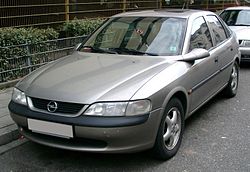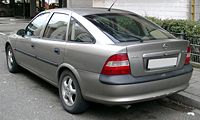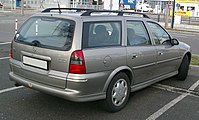Opel Vectra B.
| Opel | |
|---|---|
|
Opel Vectra hatchback "Basis" (1995–1999)
|
|
| Vectra B | |
| Production period: | 1995-2002 |
| Class : | Middle class |
| Body versions : | Sedan , hatchback , station wagon |
| Engines: |
Otto engines : 1.6–3.0 liters (55–162 kW) Diesel engines : 1.7–2.2 liters (60–92 kW) |
| Length: | 4477-4490 mm |
| Width: | 1707 mm |
| Height: | 1425-1490 mm |
| Wheelbase : | 2637 mm |
| Empty weight : | 1245-1560 kg |
| Previous model | Opel Vectra A. |
| successor | Opel Vectra C. |
| Stars in the Euro NCAP - Crash Test |
|
The Opel Vectra B is a mid-range vehicle from Opel . It was developed by October 1995 bis April 2002 built and broke its predecessor Vectra A from. Initially available again as a sedan with a notchback and hatchback, a year later, for the first time since 1975, a station wagon came onto the market under the sales name “Caravan” in the mid-range Opel segment. From March 1999 the series was sold in a revised version ( facelift ).
In April 2002, he was by his successor Vectra C replaced.
Model history
General
In October 1995 the Vectra B came on the market as a four-door notchback and five-door hatchback . More than 20 years after the end of the Ascona A , which until then was the only station wagon in the mid-range from Opel, a station wagon was offered again from September 1996 under the traditional name of Caravan .
Between 1995 and 1999, a total of four different equipment variants were offered:
- Vectra Basis (including "BelAir" and "Beauty")
- Vectra "CD"
- Vectra "Sport" (from 1.8 16v (see below))
- Vectra "CD Exclusive"; also "CDX" (see below)
The Vectra "Sport" received some sporty adjustments with components from the in-house tuner Irmscher . This initially had 16 ″ x 7J (205/55 R16) tires with so-called "twin-spoke" aluminum rims, as well as a sporty chassis that lowered the vehicle compared to the other equipment lines. Depending on the year of construction, two different sports suspensions were installed ("irmscher" sports suspension 30 mm lower [Rote Federn, 1995–1998], original Opel suspension 20 mm lower [Schwarze Federn, 1998–2002]). From summer 2001, the sports version was delivered with modified front and rear bumpers, partial leather sports seats and 17 "aluminum wheels. Sporty carbon strips on the B and C-pillars as well as darkened indicators and reversing lights brought the CD Exklusiv as well as the special models i500 and i30 , “Basis” and “CD” were equipped with B and C pillars in the same color as the car, as well as with white indicators and reversing lights. From the facelift onwards, all models were sold with darkened indicators and reversing lights as standard.
Facelift
In March 1999 all versions got a facelift . The main changes were:
- Redesigned front and rear sections ( clear glass headlights , modified rear lights, subtly revised bumpers, etc.)
- new paints
- other side skirts
- larger exterior mirrors
- painted door handles
- slight changes in equipment and interior (e.g. new instrument cluster)
- Chrome door opener in the interior
- redesigned switch unit
- Revised taillights
(The rear lights can be recognized by the curvature with an edge in the glass, was only installed in the hatchback and the notchback sedan) The tailgate was also provided with the edge.
- all models with 5-hole wheel hubs and 195/65 R as new basic tires
- Designations of the equipment lines have been changed (so the Vectra B, which was initially named "CD Exklusiv" until 1999, was ultimately called "Comfort")
The X18XE engine, for example, has been replaced by the X18XE1 , and the remaining engines (model year 2001) have also been partially revised, replaced or improved. In addition, the diesel engines were revised and new units were introduced, such as B. the 2.2 DTI.
The Vectra B was also - at least initially - very successful in Germany. Even if, like his predecessor, he never managed to take first place in the middle class, he was in the top 10 of the registration statistics for a long time. In its most successful year (1997) 140,964 units were sold, while in the last full year (2001) it was only 47,171 units.
The Vectra was available with a total of seven different petrol engines.
Engines
Petrol engines
| model | Engine type | Displacement | Motor type | Power at 1 / min | Torque (Nm at 1 / min) |
0-100 km / h | V max | construction time | particularities |
|---|---|---|---|---|---|---|---|---|---|
| 1.6 | 16LZ2 | 1598 cc | R4 8V | 55 kW (75 PS) / 5400 | 120/2200 | 175 km / h | 08 / 1995-08 / 2000 |
|
|
| X16SZR | 55 kW (75 PS) / 5200 | 128/2800 | 15.5 s | Euro 2 / D3 | |||||
| 1.6 | X16XEL | 1598 cc | R4 16V | 74 kW (100 PS) / 6200 | 150/3200 | 12.5 s | 188 km / h | 08 / 1995-08 / 2000 | Euro 2 |
| Y16XE | 74 kW (100 PS) / 6000 | 150/3600 | 193 km / h | 08 / 2000-02 / 2002 | Euro 3 | ||||
| Z16XE | Euro 4 | ||||||||
| 1.8 | X18XE | 1799 cc | R4 16V | 85 kW (115 PS) / 5400 | 170/3600 | 11.0 s | 203 km / h | 08/1995–01/1999 | Euro 3 / D3 |
| X18XE1 | 1796 cc | 170/3400 | 01 / 1999-08 / 2000 | ||||||
| Z18XE | 92 kW (125 PS) / 5600 | 170/3800 | 10.5 s | 208 km / h | 08 / 2000-02 / 2002 | Euro 4 | |||
| Z18XEL | 85 kW (115 PS) / 5600 | 11.0 s | 203 km / h |
|
|||||
| 2.0 | 20NEJ | 1998 cc | R4 8V | 82 kW (112 PS) / 5400 | 165/2800 | 195 km / h | 08 / 1995-08 / 2000 |
|
|
| 2.0 | X20XEV | 1998 cc | R4 16V | 100 kW (136 PS) / 5600 | 188/3200 | 10.0 s | 215 km / h | 08 / 1995-08 / 2000 | Euro 2 |
| 2.2 | Z22SE | 2198 cc | R4 16V | 108 kW (147 PS) / 5800 | 203/4000 | 9.5 s | 218 km / h | 08 / 2000-02 / 2002 | Euro 4 |
| 2.5 | X25XE | 2498 cc | V6 24V | 125 kW (170 PS) / 5800 | 230/3200 | 8.0 s | 230 km / h | 08 / 1995-08 / 2000 | Euro 4 |
| 2.5 i500 | X25XEI | 2498 cc | V6 24V | 143 kW (195 PS) / 6500 | 240/3500 | 7.9 s | 236 km / h | 12 / 1997-08 / 2000 |
|
| 2.6 | Y26SE | 2597 cc | V6 24V | 125 kW (170 PS) / 5800 | 250/3600 | 8.5 s | 230 km / h | 08 / 2000-02 / 2002 | Euro 3 |
| 3.0 i30 | X30XEI | 2962 cc | V6 24V | 162 kW (220 PS) / 6200 | 300/3600 | 6.9 s | 242 km / h | 1998 |
|
Diesel engines
| model | Engine type | Displacement | Motor type | Power at 1 / min | Torque (Nm at 1 / min) |
0-100 km / h | V max | construction time | particularities |
|---|---|---|---|---|---|---|---|---|---|
| 1.7 TD | X17DT | 1686 cc | R4 8V | 60 kW (82 PS) / 4400 | 168/2400 | 15.5 s | 175 km / h | 08 / 1995-12 / 1997 |
|
| 2.0 TUE | X20DTL | 1995 cc | R4 16V | 60 kW (82 PS) / 4300 | 185 / 1800-2500 | 14.5 s | 178 km / h | 09 / 1996-08 / 2000 |
|
| 2.0 DTI | X20DTH | 1995 cc | R4 16V | 74 kW (100 PS) / 4300 | 205 / 1600-2750 | 13.0 s | 195 km / h | 08 / 1997-08 / 2000 |
|
| 2.0 DTI | Y20DTH | 1995 cc | R4 16V | 74 kW (100 PS) / 4300 | 230 / 1950-2500 | 13.0 s | 195 km / h | 08 / 2000-02 / 2002 |
|
| 2.2 DTI | Y22DTR | 2172 cc | R4 16V | 92 kW (125 PS) / 4000 | 270 / 1500-2750 | 10.5 s | 207 km / h | 08 / 2000-02 / 2002 |
|
| 2.2 DTI | Y22DTR | 2172 cc | R4 16V | 88 kW (120 PS) / 4000 | 270 / 1500-2750 | k. A. | 204 km / h | 08 / 2000-02 / 2002 |
|
The direct injection diesel engines are all equipped with a maintenance-free timing chain, so that no costly replacement of the timing belt is necessary. The elaborate technology was able to successfully undercut the standard consumption of the TDI engines from the VW Group, but were initially designed to be weaker than these in terms of torque and power. Problems arose in the early days with turbochargers, oil consumption and repeatedly with the air mass meters and injection pumps (model VP44) from Bosch . The motors themselves are considered to be robust and durable. The supplier for the 1.7 TD was the Japanese car company Isuzu , the 2.0 and 2.2 l direct injection engines were in-house developments and were built in Kaiserslautern.
Possible equipment: fabric or leather, wood or titanium look, electric windows, air conditioning or automatic, CD radio, on-board computer, 4-speed automatic transmission or 5-speed manual gearbox, cruise control, navigation system, side airbags (from 07/1997), Xenon headlights (from 08/1999), heated seats, electrically adjustable and heated exterior mirrors.
Special versions
The Vectra i500 is a model modified by Irmscher with a front and rear apron as well as side skirts and rear spoiler based on the STW championship at the time . The modified 2.5 V6 (X25XEI) engine develops 143 kW (195 PS). In the interior there were console panels painted in titanium colors instead of black plastic and extensive standard equipment with Irmscher sports steering wheel. A sporty chassis with a 20 mm lower body and 17 " BBS aluminum wheels complete this sport version of the Vectra. It was available as a sedan or caravan and was built from December 1997 to August 2000.
There was also a Vectra i30 (officially there should be 30 units, but only 23 caravans were built and sold) with a 3.0 V6 engine (X30XEI) that developed 162 kW (220 PS). Except for the grill without the Opel logo and the 17 "Irmscher twin-spoke aluminum wheels, it looked like the i500 . The i30 was a limited special model for the 30th anniversary of the Irmscher company from Remshalden. The original price at that time was depending on the Equipment at around DM 90,000.00 In addition to the i30 Caravan, there were also two sedans: First a model from 1996 that served as a test vehicle for the i500 and later for the i30 .
There was also a revised model in star silver, the iS3 . This model was shown at the Essen Motor Show and also had the 220 hp 3.0 liter V6 engine. Outwardly it was identical to the i500 except for the radiator grille and the 18 "wheels ; the interior could be customized with different colored leather upholstery on request.
From the summer of 1995 to the beginning of 2002 there was a sports version, but - like the "CD-Exklusiv" model only from the 1.8 16V engine - to be recognized by: tinted taillights (red / black), which the CDX also had, and Irmscher Twin -Spoke aluminum wheels in 16 ", aluminum / titanium look in the interior and carbon look * on the doors. From summer 2001 the sport version was delivered with modified front and rear bumpers, partial leather sport seats and 17" aluminum wheels.
- also with CD-Exklusiv
Derivatives
For the North American market, the Saturn L-series was developed as a four-door sedan and a five-door station wagon based on the Vectra B. In Australia it was offered as Holden Vectra , in Great Britain as Vauxhall Vectra, in Brazil as Chevrolet Vectra. The only difference was the front grille and the emblems. However, there were also minor market-typical changes (e.g. clear glass taillights on the Chevrolet).
literature
- This is how it's done . Opel Vectra B from 10/95 to 02/02 , Delius Klasing Verlag, Bielefeld 1996, ISBN 3-7688-0943-9 .
- Opel Vectra owner's manual . Adam Opel AG, May 2001.
- Opel Vectra sales brochure . Adam Opel AG, February 2000.
Web links
Individual evidence
- ↑ Crash test Opel Vectra (2001)
- ↑ a b c d e Eckhart Bartels, Rainer Manthey: Opel: Vehicle Chronicle Volume 3: 1991–2012. Podszun, Brilon 2013, ISBN 978-3-86133-666-2 , pp. 7/8 and 35/36.









